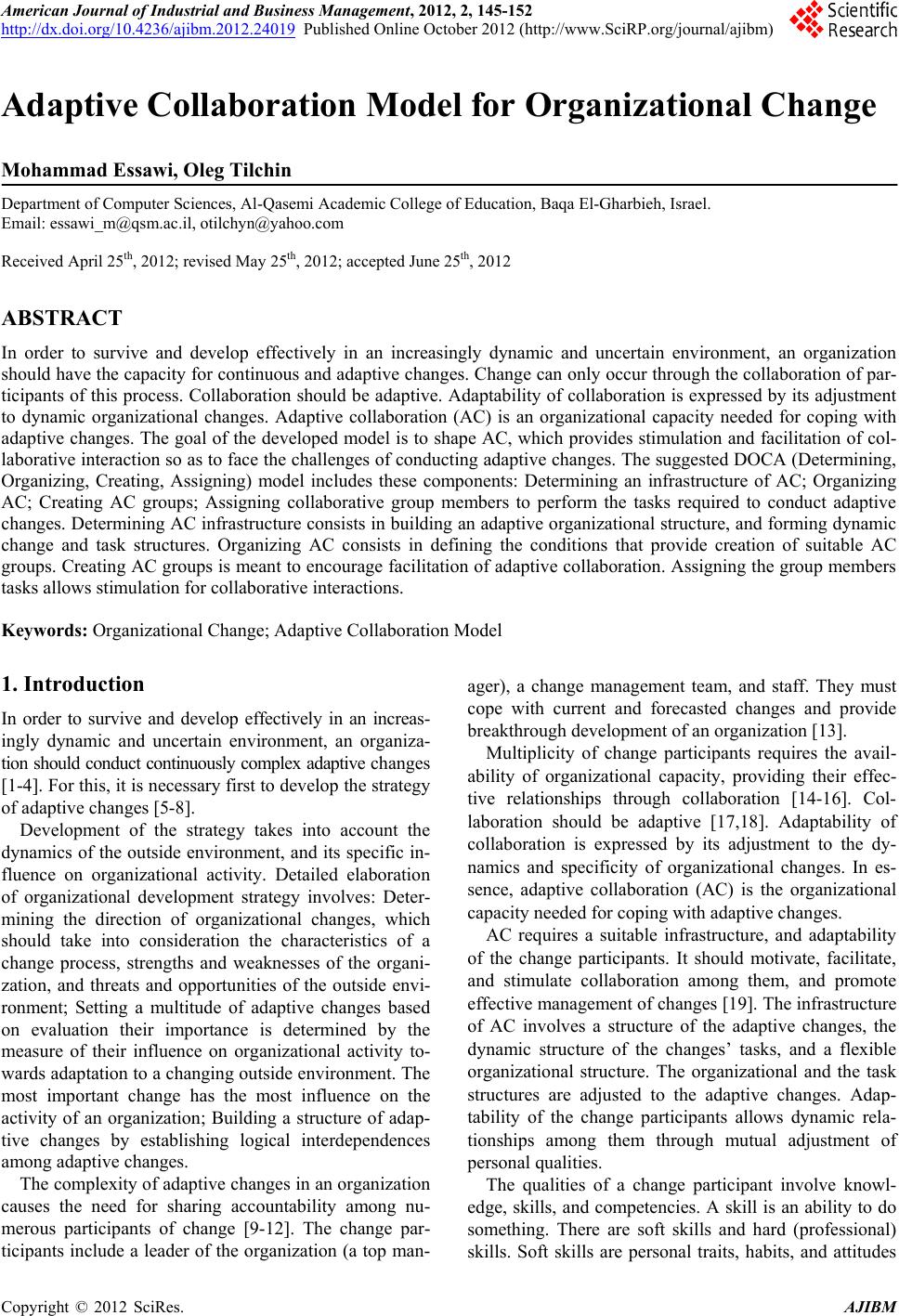 American Journal of Industrial and Business Management, 2012, 2, 145-152 http://dx.doi.org/10.4236/ajibm.2012.24019 Published Online October 2012 (http://www.SciRP.org/journal/ajibm) 145 Adaptive Collaboration Model for Organizational Change Mohammad Essawi, Oleg Tilchin Department of Computer Sciences, Al-Qasemi Academic College of Education, Baqa El-Gharbieh, Israel. Email: essawi_m@qsm.ac.il, otilchyn@yahoo.com Received April 25th, 2012; revised May 25th, 2012; accepted June 25th, 2012 ABSTRACT In order to survive and develop effectively in an increasingly dynamic and uncertain environment, an organization should have the capacity for continuous and adaptive changes. Change can only occur through the collaboration of par- ticipants of this process. Collaboration should be adaptive. Adaptability of collaboration is expressed by its adjustment to dynamic organizational changes. Adaptive collaboration (AC) is an organizational capacity needed for coping with adaptive changes. The goal of the developed model is to shape AC, which provides stimulation and facilitation of col- laborative interaction so as to face the challenges of conducting adaptive changes. The suggested DOCA (Determining, Organizing, Creating, Assigning) model includes these components: Determining an infrastructure of AC; Organizing AC; Creating AC groups; Assigning collaborative group members to perform the tasks required to conduct adaptive changes. Determining AC infrastructure consists in building an adaptive organizational structure, and forming dynamic change and task structures. Organizing AC consists in defining the conditions that provide creation of suitable AC groups. Creating AC groups is meant to encourage facilitation of adaptive collaboration. Assigning the group members tasks allows stimulation for collaborative interactions. Keywords: Organizational Change; Adaptive Collaboration Model 1. Introduction In order to survive and develop effectively in an increas- ingly dynamic and uncertain environment, an organiza- tion should conduct continuously complex adaptive changes [1-4]. For this, it is necessary first to develop the strategy of adaptive changes [5-8]. Development of the strategy takes into account the dynamics of the outside environment, and its specific in- fluence on organizational activity. Detailed elaboration of organizational development strategy involves: Deter- mining the direction of organizational changes, which should take into consideration the characteristics of a change process, strengths and weaknesses of the organi- zation, and threats and opportunities of the outside envi- ronment; Setting a multitude of adaptive changes based on evaluation their importance is determined by the measure of their influence on organizational activity to- wards adaptation to a changing outside environment. The most important change has the most influence on the activity of an organization; Building a structure of adap- tive changes by establishing logical interdependences among adaptive changes. The complexity of adaptive changes in an organization causes the need for sharing accountability among nu- merous participants of change [9-12]. The change par- ticipants include a leader of the organization (a top man- ager), a change management team, and staff. They must cope with current and forecasted changes and provide breakthrough development of an organization [13]. Multiplicity of change participants requires the avail- ability of organizational capacity, providing their effec- tive relationships through collaboration [14-16]. Col- laboration should be adaptive [17,18]. Adaptability of collaboration is expressed by its adjustment to the dy- namics and specificity of organizational changes. In es- sence, adaptive collaboration (AC) is the organizational capacity needed for coping with adaptive changes. AC requires a suitable infrastructure, and adaptability of the change participants. It should motivate, facilitate, and stimulate collaboration among them, and promote effective management of changes [19]. The infrastructure of AC involves a structure of the adaptive changes, the dynamic structure of the changes’ tasks, and a flexible organizational structure. The organizational and the task structures are adjusted to the adaptive changes. Adap- tability of the change participants allows dynamic rela- tionships among them through mutual adjustment of personal qualities. The qualities of a change participant involve knowl- edge, skills, and competencies. A skill is an ability to do something. There are soft skills and hard (professional) skills. Soft skills are personal traits, habits, and attitudes Copyright © 2012 SciRes. AJIBM 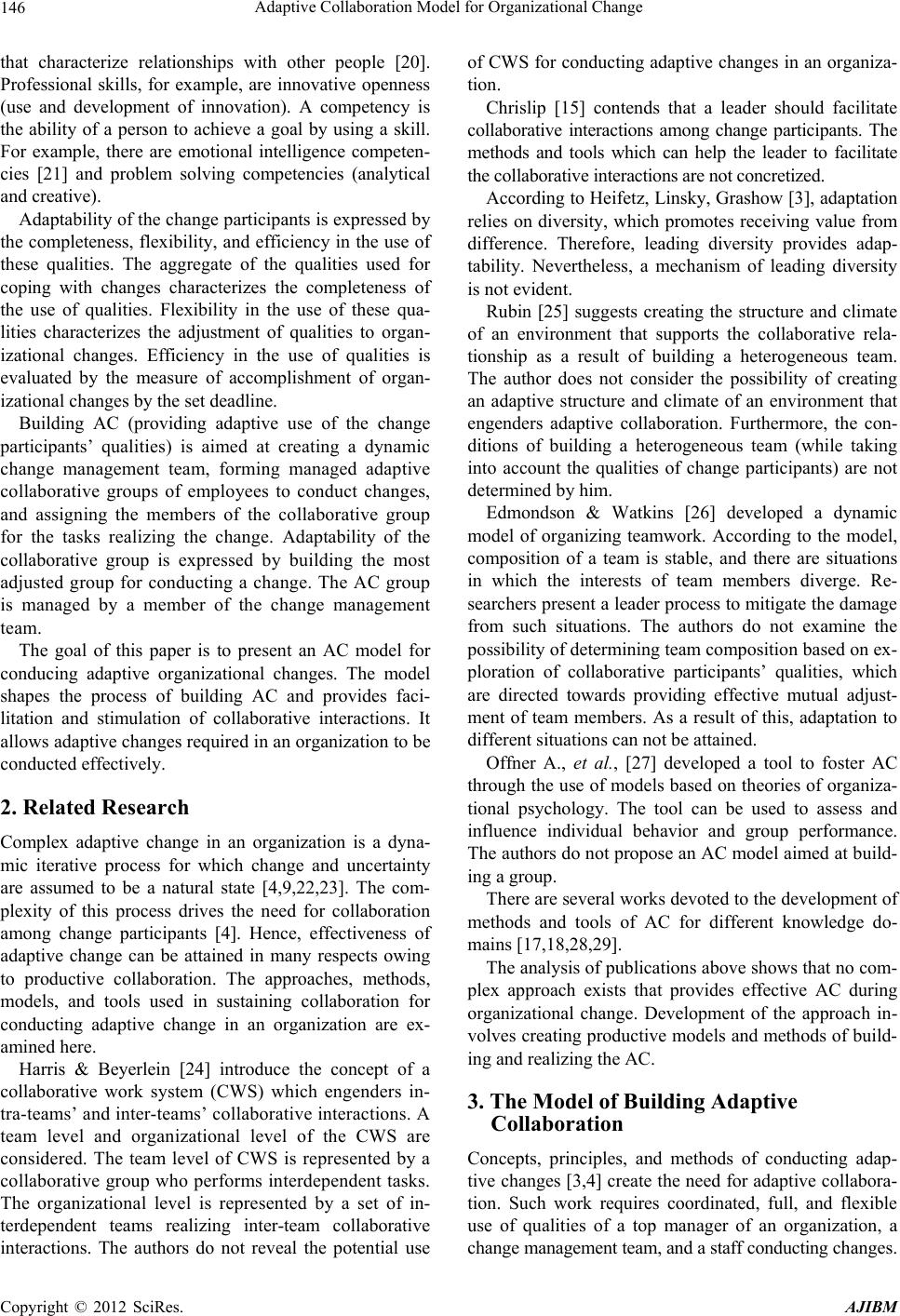 Adaptive Collaboration Model for Organizational Change 146 that characterize relationships with other people [20]. Professional skills, for example, are innovative openness (use and development of innovation). A competency is the ability of a person to achieve a goal by using a skill. For example, there are emotional intelligence competen- cies [21] and problem solving competencies (analytical and creative). Adaptability of the change participants is expressed by the completeness, flexibility, and efficiency in the use of these qualities. The aggregate of the qualities used for coping with changes characterizes the completeness of the use of qualities. Flexibility in the use of these qua- lities characterizes the adjustment of qualities to organ- izational changes. Efficiency in the use of qualities is evaluated by the measure of accomplishment of organ- izational changes by the set deadline. Building AC (providing adaptive use of the change participants’ qualities) is aimed at creating a dynamic change management team, forming managed adaptive collaborative groups of employees to conduct changes, and assigning the members of the collaborative group for the tasks realizing the change. Adaptability of the collaborative group is expressed by building the most adjusted group for conducting a change. The AC group is managed by a member of the change management team. The goal of this paper is to present an AC model for conducing adaptive organizational changes. The model shapes the process of building AC and provides faci- litation and stimulation of collaborative interactions. It allows adaptive changes required in an organization to be conducted effectively. 2. Related Research Complex adaptive change in an organization is a dyna- mic iterative process for which change and uncertainty are assumed to be a natural state [4,9,22,23]. The com- plexity of this process drives the need for collaboration among change participants [4]. Hence, effectiveness of adaptive change can be attained in many respects owing to productive collaboration. The approaches, methods, models, and tools used in sustaining collaboration for conducting adaptive change in an organization are ex- amined here. Harris & Beyerlein [24] introduce the concept of a collaborative work system (CWS) which engenders in- tra-teams’ and inter-teams’ collaborative interactions. A team level and organizational level of the CWS are considered. The team level of CWS is represented by a collaborative group who performs interdependent tasks. The organizational level is represented by a set of in- terdependent teams realizing inter-team collaborative interactions. The authors do not reveal the potential use of CWS for conducting adaptive changes in an organiza- tion. Chrislip [15] contends that a leader should facilitate collaborative interactions among change participants. The methods and tools which can help the leader to facilitate the collaborative interactions are not concretized. According to Heifetz, Linsky, Grashow [3], adaptation relies on diversity, which promotes receiving value from difference. Therefore, leading diversity provides adap- tability. Nevertheless, a mechanism of leading diversity is not evident. Rubin [25] suggests creating the structure and climate of an environment that supports the collaborative rela- tionship as a result of building a heterogeneous team. The author does not consider the possibility of creating an adaptive structure and climate of an environment that engenders adaptive collaboration. Furthermore, the con- ditions of building a heterogeneous team (while taking into account the qualities of change participants) are not determined by him. Edmondson & Watkins [26] developed a dynamic model of organizing teamwork. According to the model, composition of a team is stable, and there are situations in which the interests of team members diverge. Re- searchers present a leader process to mitigate the damage from such situations. The authors do not examine the possibility of determining team composition based on ex- ploration of collaborative participants’ qualities, which are directed towards providing effective mutual adjust- ment of team members. As a result of this, adaptation to different situations can not be attained. Offner A., et al., [27] developed a tool to foster AC through the use of models based on theories of organiza- tional psychology. The tool can be used to assess and influence individual behavior and group performance. The authors do not propose an AC model aimed at build- ing a group. There are several works devoted to the development of methods and tools of AC for different knowledge do- mains [17,18,28,29]. The analysis of publications above shows that no com- plex approach exists that provides effective AC during organizational change. Development of the approach in- volves creating productive models and methods of build- ing and realizing the AC. 3. The Model of Building Adaptive Collaboration Concepts, principles, and methods of conducting adap- tive changes [3,4] create the need for adaptive collabora- tion. Such work requires coordinated, full, and flexible use of qualities of a top manager of an organization, a change management team, and a staff conducting changes. Copyright © 2012 SciRes. AJIBM 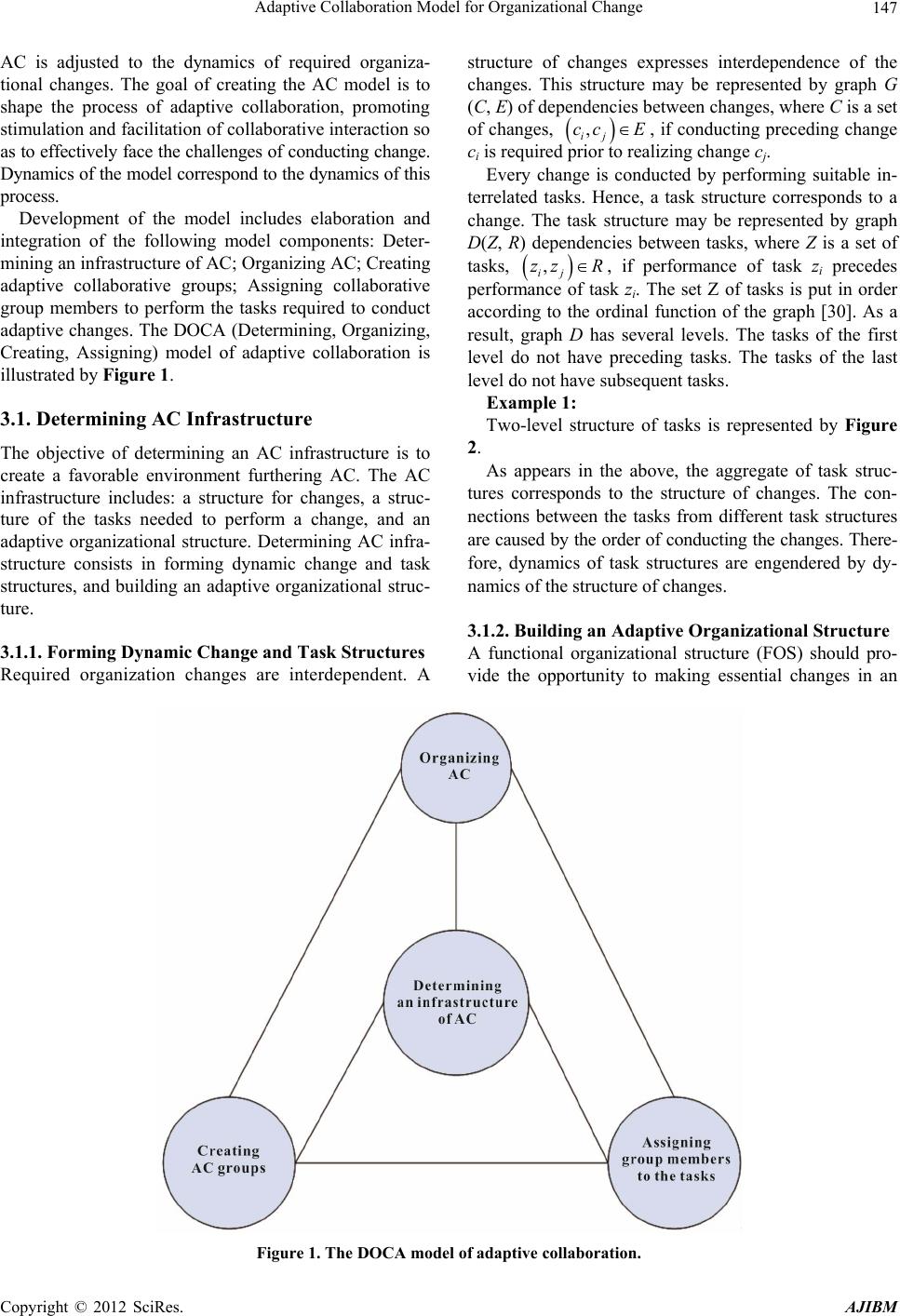 Adaptive Collaboration Model for Organizational Change Copyright © 2012 SciRes. AJIBM 147 structure of changes expresses interdependence of the changes. This structure may be represented by graph G (C, E) of dependencies between changes, where C is a set of changes, , ij cc E , if conducting preceding change ci is required prior to realizing change cj. AC is adjusted to the dynamics of required organiza- tional changes. The goal of creating the AC model is to shape the process of adaptive collaboration, promoting stimulation and facilitation of collaborative interaction so as to effectively face the challenges of conducting change. Dynamics of the model correspond to the dynamics of this process. Every change is conducted by performing suitable in- terrelated tasks. Hence, a task structure corresponds to a change. The task structure may be represented by graph D(Z, R) dependencies between tasks, where Z is a set of tasks, , ij zz R , if performance of task zi precedes performance of task zi. The set Z of tasks is put in order according to the ordinal function of the graph [30]. As a result, graph D has several levels. The tasks of the first level do not have preceding tasks. The tasks of the last level do not have subsequent tasks. Development of the model includes elaboration and integration of the following model components: Deter- mining an infrastructure of AC; Organizing AC; Creating adaptive collaborative groups; Assigning collaborative group members to perform the tasks required to conduct adaptive changes. The DOCA (Determining, Organizing, Creating, Assigning) model of adaptive collaboration is illustrated by Figure 1. Example 1: 3.1. Determining AC Infrastructure Two-level structure of tasks is represented by Figure 2. The objective of determining an AC infrastructure is to create a favorable environment furthering AC. The AC infrastructure includes: a structure for changes, a struc- ture of the tasks needed to perform a change, and an adaptive organizational structure. Determining AC infra- structure consists in forming dynamic change and task structures, and building an adaptive organizational struc- ture. As appears in the above, the aggregate of task struc- tures corresponds to the structure of changes. The con- nections between the tasks from different task structures are caused by the order of conducting the changes. There- fore, dynamics of task structures are engendered by dy- namics of the structure of changes. 3.1.2. Building an Adaptive Organizational Structure 3.1.1. Formin g Dynamic Change and Task Structures A functional organizational structure (FOS) should pro- vide the opportunity to making essential changes in an Required organization changes are interdependent. A Figure 1. The DOCA model of adaptive collaboration. 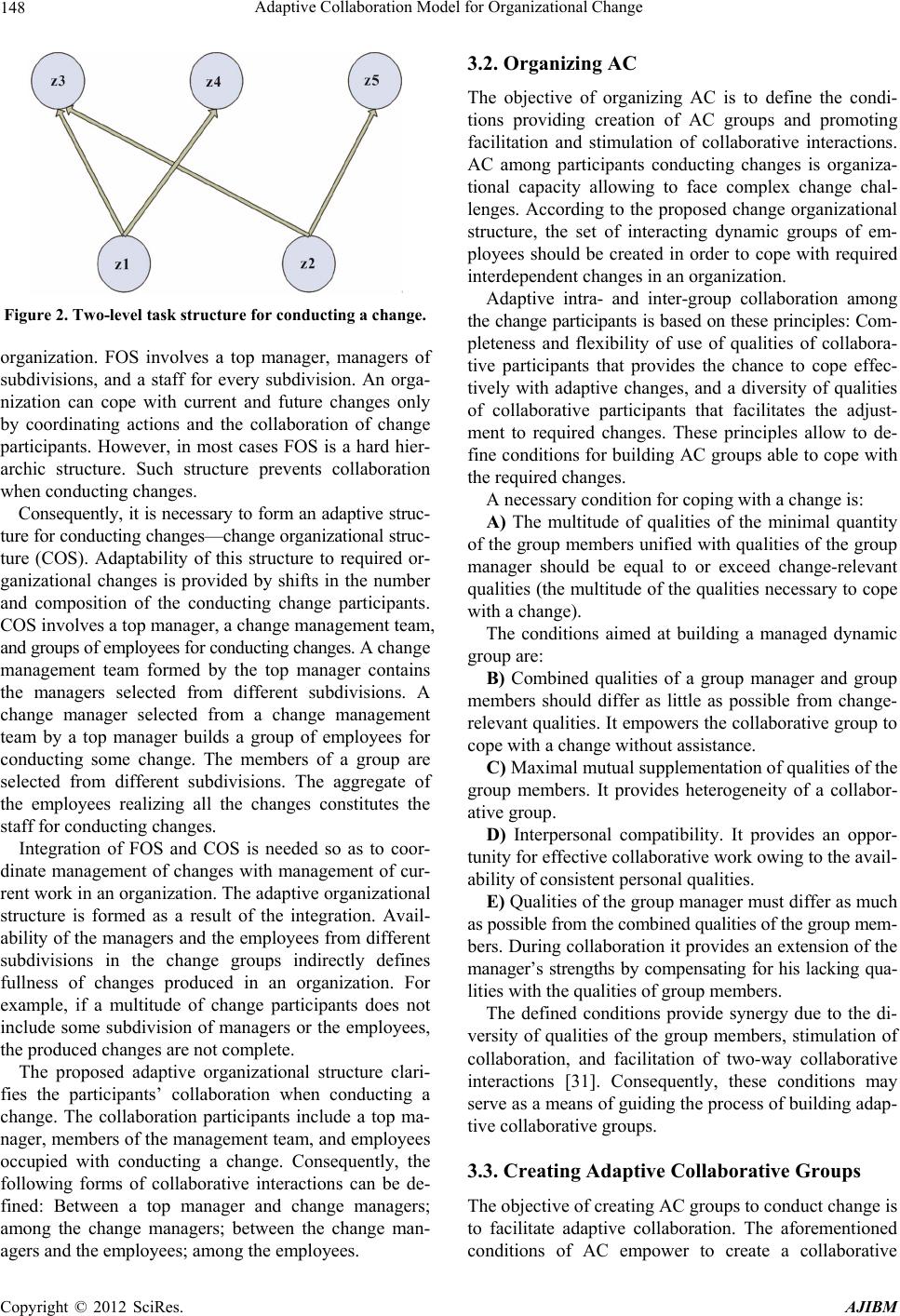 Adaptive Collaboration Model for Organizational Change 148 Figure 2. Two-le vel task structure for conducting a change. organization. FOS involves a top manager, managers of subdivisions, and a staff for every subdivision. An orga- nization can cope with current and future changes only by coordinating actions and the collaboration of change participants. However, in most cases FOS is a hard hier- archic structure. Such structure prevents collaboration when conducting changes. Consequently, it is necessary to form an adaptive struc- ture for conducting changes—change organizational struc- ture (COS). Adaptability of this structure to required or- ganizational changes is provided by shifts in the number and composition of the conducting change participants. COS involves a top manager, a change management team, and groups of employees for conducting changes. A change management team formed by the top manager contains the managers selected from different subdivisions. A change manager selected from a change management team by a top manager builds a group of employees for conducting some change. The members of a group are selected from different subdivisions. The aggregate of the employees realizing all the changes constitutes the staff for conducting changes. Integration of FOS and COS is needed so as to coor- dinate management of changes with management of cur- rent work in an organization. The adaptive organizational structure is formed as a result of the integration. Avail- ability of the managers and the employees from different subdivisions in the change groups indirectly defines fullness of changes produced in an organization. For example, if a multitude of change participants does not include some subdivision of managers or the employees, the produced changes are not complete. The proposed adaptive organizational structure clari- fies the participants’ collaboration when conducting a change. The collaboration participants include a top ma- nager, members of the management team, and employees occupied with conducting a change. Consequently, the following forms of collaborative interactions can be de- fined: Between a top manager and change managers; among the change managers; between the change man- agers and the employees; among the employees. 3.2. Organizing AC The objective of organizing AC is to define the condi- tions providing creation of AC groups and promoting facilitation and stimulation of collaborative interactions. AC among participants conducting changes is organiza- tional capacity allowing to face complex change chal- lenges. According to the proposed change organizational structure, the set of interacting dynamic groups of em- ployees should be created in order to cope with required interdependent changes in an organization. Adaptive intra- and inter-group collaboration among the change participants is based on these principles: Com- pleteness and flexibility of use of qualities of collabora- tive participants that provides the chance to cope effec- tively with adaptive changes, and a diversity of qualities of collaborative participants that facilitates the adjust- ment to required changes. These principles allow to de- fine conditions for building AC groups able to cope with the required changes. A necessary condition for coping with a change is: A) The multitude of qualities of the minimal quantity of the group members unified with qualities of the group manager should be equal to or exceed change-relevant qualities (the multitude of the qualities necessary to cope with a change). The conditions aimed at building a managed dynamic group are: B) Combined qualities of a group manager and group members should differ as little as possible from change- relevant qualities. It empowers the collaborative group to cope with a change without assistance. C) Maximal mutual supplementation of qualities of the group members. It provides heterogeneity of a collabor- ative group. D) Interpersonal compatibility. It provides an oppor- tunity for effective collaborative work owing to the avail- ability of consistent personal qualities. E) Qualities of the group manager must differ as much as possible from the combined qualities of the group mem- bers. During collaboration it provides an extension of the manager’s strengths by compensating for his lacking qua- lities with the qualities of group members. The defined conditions provide synergy due to the di- versity of qualities of the group members, stimulation of collaboration, and facilitation of two-way collaborative interactions [31]. Consequently, these conditions may serve as a means of guiding the process of building adap- tive collaborative groups. 3.3. Creating Adaptive Collaborative Groups The objective of creating AC groups to conduct change is to facilitate adaptive collaboration. The aforementioned conditions of AC empower to create a collaborative Copyright © 2012 SciRes. AJIBM 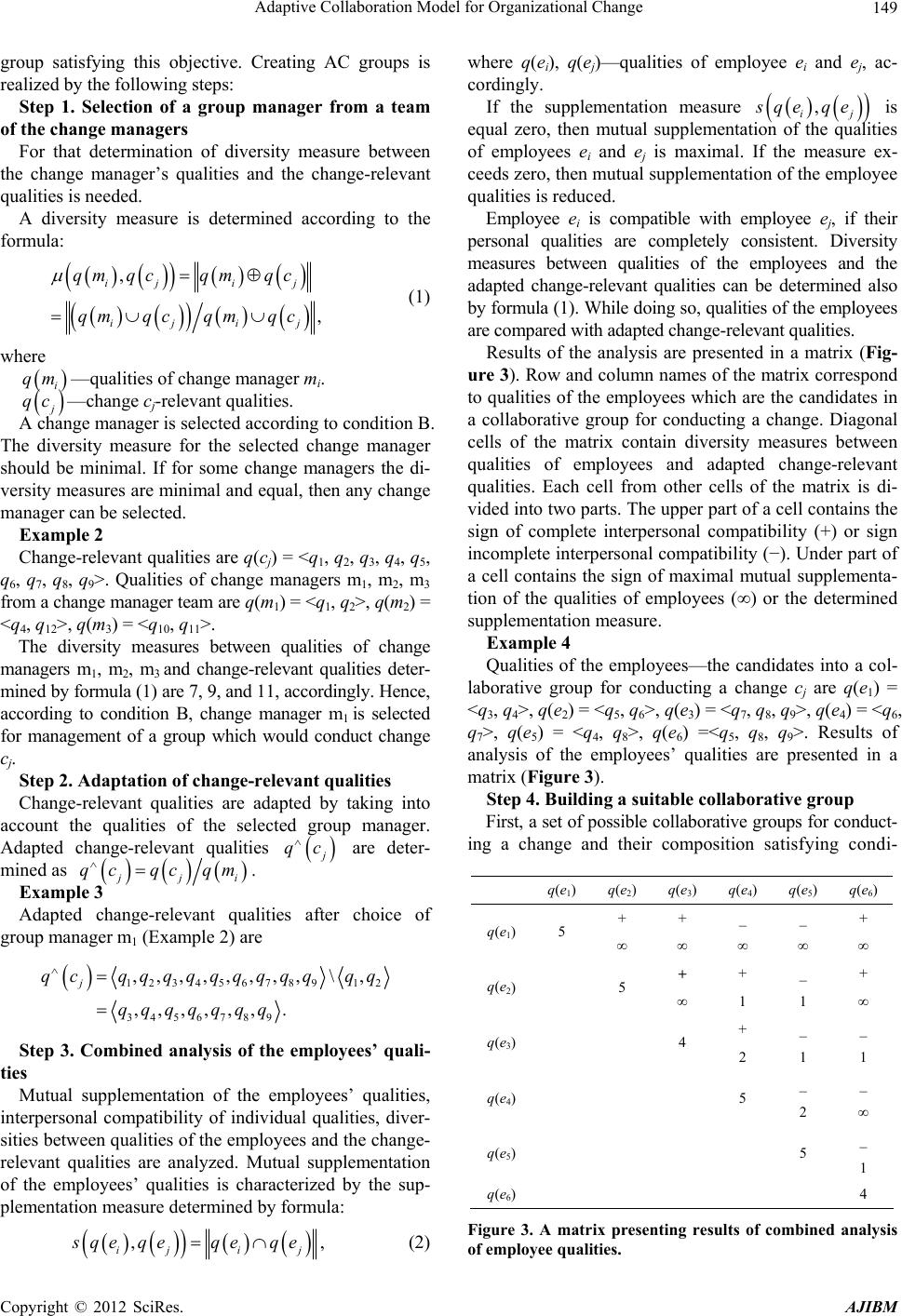 Adaptive Collaboration Model for Organizational Change 149 group satisfying this objective. Creating AC groups is realized by the following steps: Step 1. Selection of a group manager from a team of the change managers For that determination of diversity measure between the change manager’s qualities and the change-relevant qualities is needed. A diversity measure is determined according to the formula: , , iji j ij ij qm qcqmqc qm qcqm qc (1) where i qm —qualities of change manager mi. qc —change cj-relevant qualities. A change manager is selected according to condition B. The diversity measure for the selected change manager should be minimal. If for some change managers the di- versity measures are minimal and equal, then any change manager can be selected. Example 2 Change-relevant qualities are q(cj) = <q1, q2, q3, q4, q5, q6, q7, q8, q9>. Qualities of change managers m1, m2, m3 from a change manager team are q(m1) = <q1, q2>, q(m2) = <q4, q12>, q(m3) = <q10, q11>. The diversity measures between qualities of change managers m1, m2, m3 and change-relevant qualities deter- mined by formula (1) are 7, 9, and 11, accordingly. Hence, according to condition B, change manager m1 is selected for management of a group which would conduct change cj. Step 2. Adaptation of change-relevant qualities Change-relevant qualities are adapted by taking into account the qualities of the selected group manager. Adapted change-relevant qualities qc are deter- mined as ji qcqc qm . Example 3 Adapted change-relevant qualities after choice of group manager m1 (Example 2) are 123456789 12 3456789 ,,,,,,,,\ , ,,,,,, . j q cqqqqqqqqqqq qq qq qqq Step 3. Combined analysis of the employees’ quali- ties Mutual supplementation of the employees’ qualities, interpersonal compatibility of individual qualities, diver- sities between qualities of the employees and the change- relevant qualities are analyzed. Mutual supplementation of the employees’ qualities is characterized by the sup- plementation measure determined by formula: , iji j qe qeqeqe, (2) where q(ei), q(ej)—qualities of employee ei and ej, ac- cordingly. If the supplementation measure , ij qe qe is equal zero, then mutual supplementation of the qualities of employees ei and ej is maximal. If the measure ex- ceeds zero, then mutual supplementation of the employee qualities is reduced. Employee ei is compatible with employee ej, if their personal qualities are completely consistent. Diversity measures between qualities of the employees and the adapted change-relevant qualities can be determined also by formula (1). While doing so, qualities of the employees are compared with adapted change-relevant qualities. Results of the analysis are presented in a matrix (Fig- ure 3). Row and column names of the matrix correspond to qualities of the employees which are the candidates in a collaborative group for conducting a change. Diagonal cells of the matrix contain diversity measures between qualities of employees and adapted change-relevant qualities. Each cell from other cells of the matrix is di- vided into two parts. The upper part of a cell contains the sign of complete interpersonal compatibility (+) or sign incomplete interpersonal compatibility (−). Under part of a cell contains the sign of maximal mutual supplementa- tion of the qualities of employees (∞) or the determined supplementation measure. Example 4 Qualities of the employees—the candidates into a col- laborative group for conducting a change cj are q(e1) = <q3, q4>, q(e2) = <q5, q6>, q(e3) = <q7, q8, q9>, q(e4) = <q6, q7>, q(e5) = <q4, q8>, q(e6) =<q5, q8, q9>. Results of analysis of the employees’ qualities are presented in a matrix (Figure 3). Step 4. Building a suitable collaborative group First, a set of possible collaborative groups for conduct- ing a change and their composition satisfying condi- q(e1) q(e2) q(e3) q(e4) q(e5) q(e6) + + _ _ + q(e1) 5 ∞ ∞ ∞ ∞ ∞ + + _ + q(e2) 5 ∞ 1 1 ∞ + _ _ q(e3) 4 2 1 1 _ _ q(e4) 5 2 ∞ _ q(e5) 5 1 q(e6) 4 Figure 3. A matrix presenting results of combined analysis of employee qualities. Copyright © 2012 SciRes. AJIBM 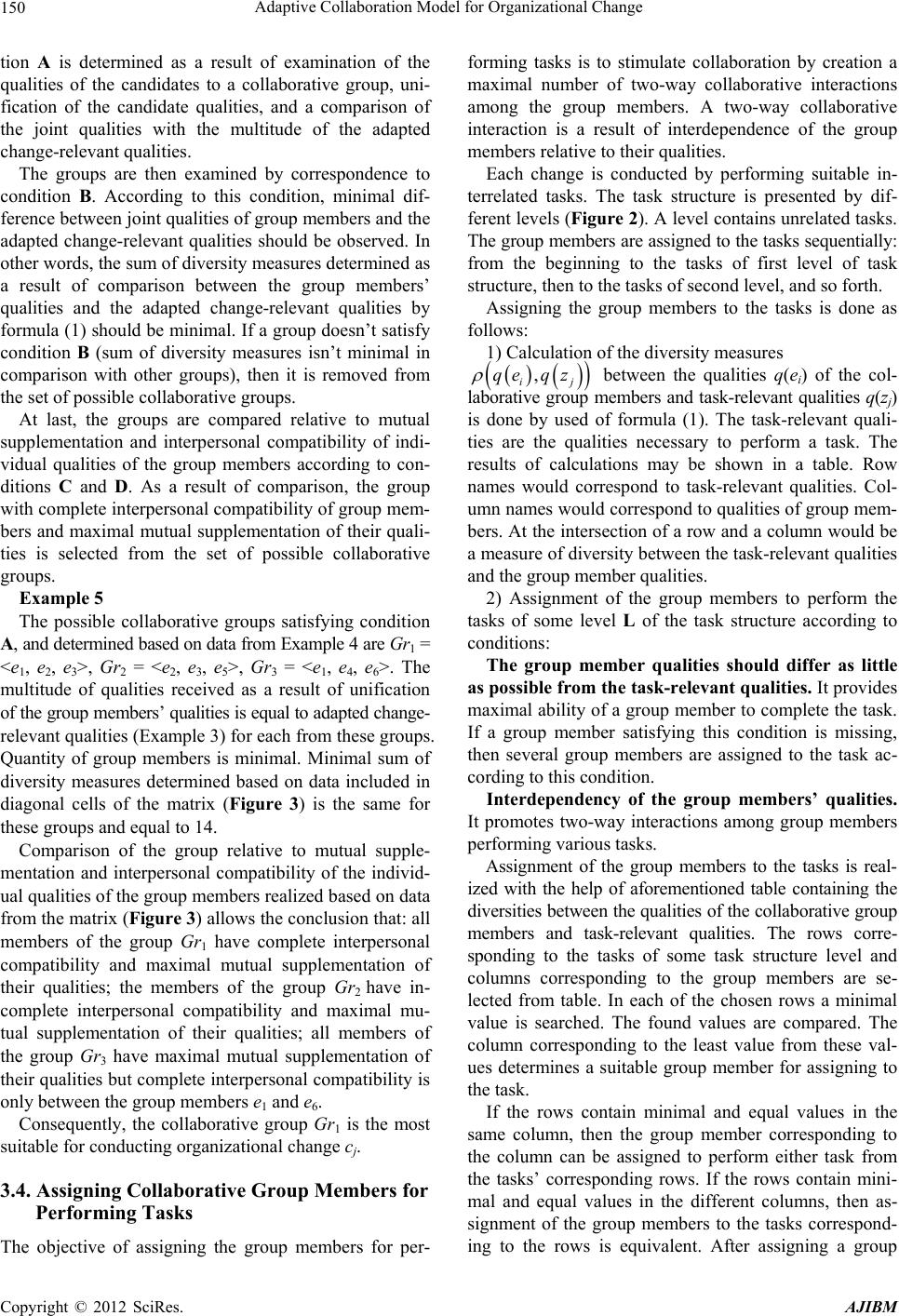 Adaptive Collaboration Model for Organizational Change 150 tion A is determined as a result of examination of the qualities of the candidates to a collaborative group, uni- fication of the candidate qualities, and a comparison of the joint qualities with the multitude of the adapted change-relevant qualities. The groups are then examined by correspondence to condition B. According to this condition, minimal dif- ference between joint qualities of group members and the adapted change-relevant qualities should be observed. In other words, the sum of diversity measures determined as a result of comparison between the group members’ qualities and the adapted change-relevant qualities by formula (1) should be minimal. If a group doesn’t satisfy condition B (sum of diversity measures isn’t minimal in comparison with other groups), then it is removed from the set of possible collaborative groups. At last, the groups are compared relative to mutual supplementation and interpersonal compatibility of indi- vidual qualities of the group members according to con- ditions C and D. As a result of comparison, the group with complete interpersonal compatibility of group mem- bers and maximal mutual supplementation of their quali- ties is selected from the set of possible collaborative groups. Example 5 The possible collaborative groups satisfying condition A, and determined based on data from Example 4 are Gr1 = <e1, e2, e3>, Gr2 = <e2, e3, e5>, Gr3 = <e1, e4, e6>. The multitude of qualities received as a result of unification of the group members’ qualities is equal to adapted change- relevant qualities (Example 3) for each from these groups. Quantity of group members is minimal. Minimal sum of diversity measures determined based on data included in diagonal cells of the matrix (Figure 3) is the same for these groups and equal to 14. Comparison of the group relative to mutual supple- mentation and interpersonal compatibility of the individ- ual qualities of the group members realized based on data from the matrix (Figure 3) allows the conclusion that: all members of the group Gr1 have complete interpersonal compatibility and maximal mutual supplementation of their qualities; the members of the group Gr2 have in- complete interpersonal compatibility and maximal mu- tual supplementation of their qualities; all members of the group Gr3 have maximal mutual supplementation of their qualities but complete interpersonal compatibility is only between the group members e1 and e6. Consequently, the collaborative group Gr1 is the most suitable for conducting organizational change cj. 3.4. Assigning Collaborative Group Members for Performing Tasks The objective of assigning the group members for per- forming tasks is to stimulate collaboration by creation a maximal number of two-way collaborative interactions among the group members. A two-way collaborative interaction is a result of interdependence of the group members relative to their qualities. Each change is conducted by performing suitable in- terrelated tasks. The task structure is presented by dif- ferent levels (Figure 2). A level contains unrelated tasks. The group members are assigned to the tasks sequentially: from the beginning to the tasks of first level of task structure, then to the tasks of second level, and so forth. Assigning the group members to the tasks is done as follows: 1) Calculation of the diversity measures , ij qe qz between the qualities q(ei) of the col- laborative group members and task-relevant qualities q(zj) is done by used of formula (1). The task-relevant quali- ties are the qualities necessary to perform a task. The results of calculations may be shown in a table. Row names would correspond to task-relevant qualities. Col- umn names would correspond to qualities of group mem- bers. At the intersection of a row and a column would be a measure of diversity between the task-relevant qualities and the group member qualities. 2) Assignment of the group members to perform the tasks of some level L of the task structure according to conditions: The group member qualities should differ as little as possible from the task-relevant qualities. It provides maximal ability of a group member to complete the task. If a group member satisfying this condition is missing, then several group members are assigned to the task ac- cording to this condition. Interdependency of the group members’ qualities. It promotes two-way interactions among group members performing various tasks. Assignment of the group members to the tasks is real- ized with the help of aforementioned table containing the diversities between the qualities of the collaborative group members and task-relevant qualities. The rows corre- sponding to the tasks of some task structure level and columns corresponding to the group members are se- lected from table. In each of the chosen rows a minimal value is searched. The found values are compared. The column corresponding to the least value from these val- ues determines a suitable group member for assigning to the task. If the rows contain minimal and equal values in the same column, then the group member corresponding to the column can be assigned to perform either task from the tasks’ corresponding rows. If the rows contain mini- mal and equal values in the different columns, then as- signment of the group members to the tasks correspond- ing to the rows is equivalent. After assigning a group Copyright © 2012 SciRes. AJIBM 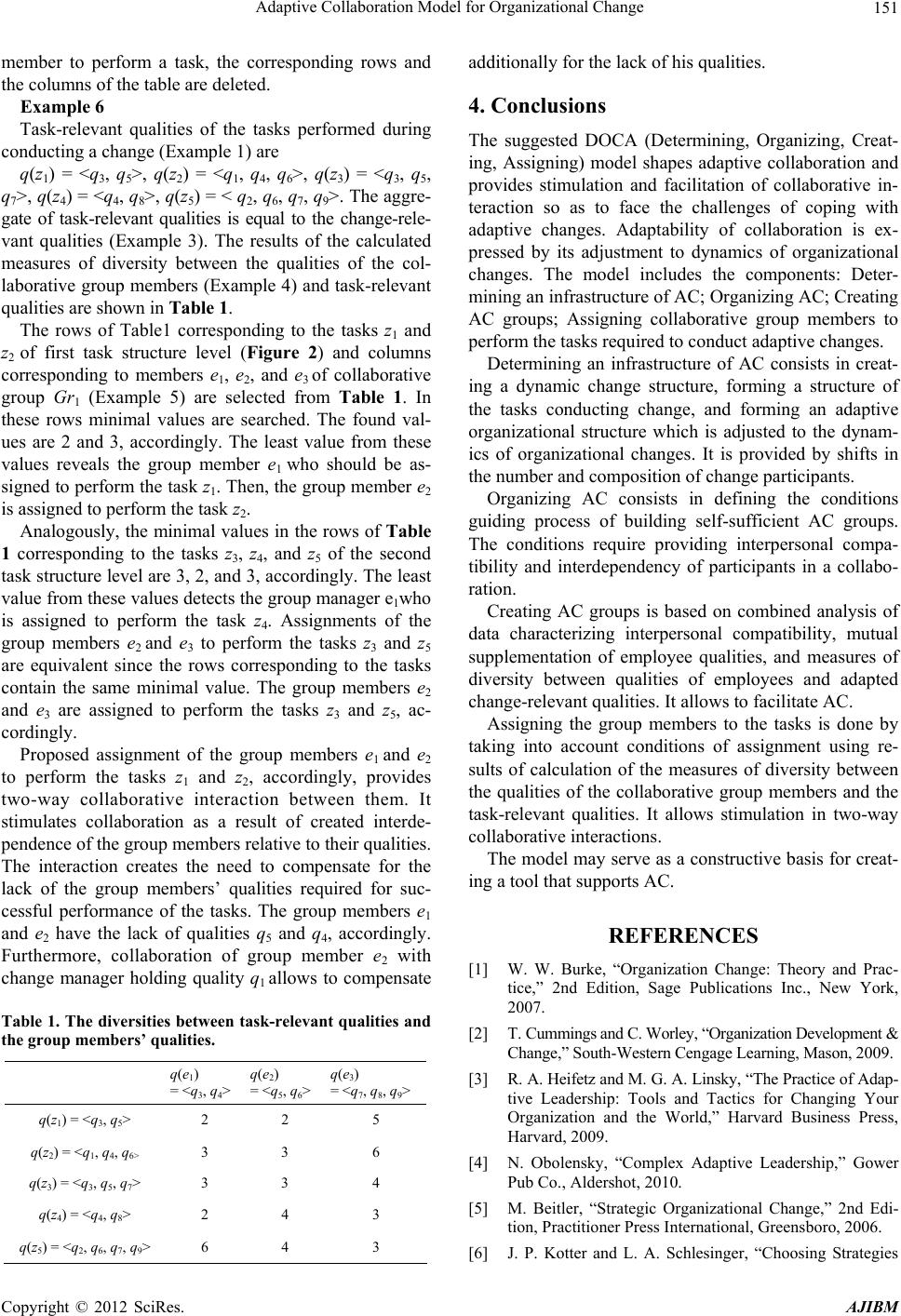 Adaptive Collaboration Model for Organizational Change 151 member to perform a task, the corresponding rows and the columns of the table are deleted. Example 6 Task-relevant qualities of the tasks performed during conducting a change (Example 1) are q(z1) = <q3, q5>, q(z2) = <q1, q4, q6>, q(z3) = <q3, q5, q7>, q(z4) = <q4, q8>, q(z5) = < q2, q6, q7, q9>. The aggre- gate of task-relevant qualities is equal to the change-rele- vant qualities (Example 3). The results of the calculated measures of diversity between the qualities of the col- laborative group members (Example 4) and task-relevant qualities are shown in Table 1. The rows of Table1 corresponding to the tasks z1 and z2 of first task structure level (Figure 2) and columns corresponding to members e1, e2, and e3 of collaborative group Gr1 (Example 5) are selected from Table 1. In these rows minimal values are searched. The found val- ues are 2 and 3, accordingly. The least value from these values reveals the group member e1 who should be as- signed to perform the task z1. Then, the group member e2 is assigned to perform the task z2. Analogously, the minimal values in the rows of Table 1 corresponding to the tasks z3, z4, and z5 of the second task structure level are 3, 2, and 3, accordingly. The least value from these values detects the group manager e1who is assigned to perform the task z4. Assignments of the group members e2 and e3 to perform the tasks z3 and z5 are equivalent since the rows corresponding to the tasks contain the same minimal value. The group members e2 and e3 are assigned to perform the tasks z3 and z5, ac- cordingly. Proposed assignment of the group members e1 and e2 to perform the tasks z1 and z2, accordingly, provides two-way collaborative interaction between them. It stimulates collaboration as a result of created interde- pendence of the group members relative to their qualities. The interaction creates the need to compensate for the lack of the group members’ qualities required for suc- cessful performance of the tasks. The group members e1 and e2 have the lack of qualities q5 and q4, accordingly. Furthermore, collaboration of group member e2 with change manager holding quality q1 allows to compensate Table 1. The diversities betw een task-relevant qualities and the group members’ qualities. q(e1) = <q3, q4> q(e2) = <q5, q6> q(e3) = <q7, q8, q9> q(z1) = <q3, q5> 2 2 5 q(z2) = <q1, q4, q6> 3 3 6 q(z3) = <q3, q5, q7> 3 3 4 q(z4) = <q4, q8> 2 4 3 q(z5) = <q2, q6, q7, q9> 6 4 3 additionally for the lack of his qualities. 4. Conclusions The suggested DOCA (Determining, Organizing, Creat- ing, Assigning) model shapes adaptive collaboration and provides stimulation and facilitation of collaborative in- teraction so as to face the challenges of coping with adaptive changes. Adaptability of collaboration is ex- pressed by its adjustment to dynamics of organizational changes. The model includes the components: Deter- mining an infrastructure of AC; Organizing AC; Creating AC groups; Assigning collaborative group members to perform the tasks required to conduct adaptive changes. Determining an infrastructure of AC consists in creat- ing a dynamic change structure, forming a structure of the tasks conducting change, and forming an adaptive organizational structure which is adjusted to the dynam- ics of organizational changes. It is provided by shifts in the number and composition of change participants. Organizing AC consists in defining the conditions guiding process of building self-sufficient AC groups. The conditions require providing interpersonal compa- tibility and interdependency of participants in a collabo- ration. Creating AC groups is based on combined analysis of data characterizing interpersonal compatibility, mutual supplementation of employee qualities, and measures of diversity between qualities of employees and adapted change-relevant qualities. It allows to facilitate AC. Assigning the group members to the tasks is done by taking into account conditions of assignment using re- sults of calculation of the measures of diversity between the qualities of the collaborative group members and the task-relevant qualities. It allows stimulation in two-way collaborative interactions. The model may serve as a constructive basis for creat- ing a tool that supports AC. REFERENCES [1] W. W. Burke, “Organization Change: Theory and Prac- tice,” 2nd Edition, Sage Publications Inc., New York, 2007. [2] T. Cummings and C. Worley, “Organization Development & Change,” South-Western Cengage Learning, Mason, 2009. [3] R. A. Heifetz and M. G. A. Linsky, “The Practice of Adap- tive Leadership: Tools and Tactics for Changing Your Organization and the World,” Harvard Business Press, Harvard, 2009. [4] N. Obolensky, “Complex Adaptive Leadership,” Gower Pub Co., Aldershot, 2010. [5] M. Beitler, “Strategic Organizational Change,” 2nd Edi- tion, Practitioner Press International, Greensboro, 2006. [6] J. P. Kotter and L. A. Schlesinger, “Choosing Strategies Copyright © 2012 SciRes. AJIBM 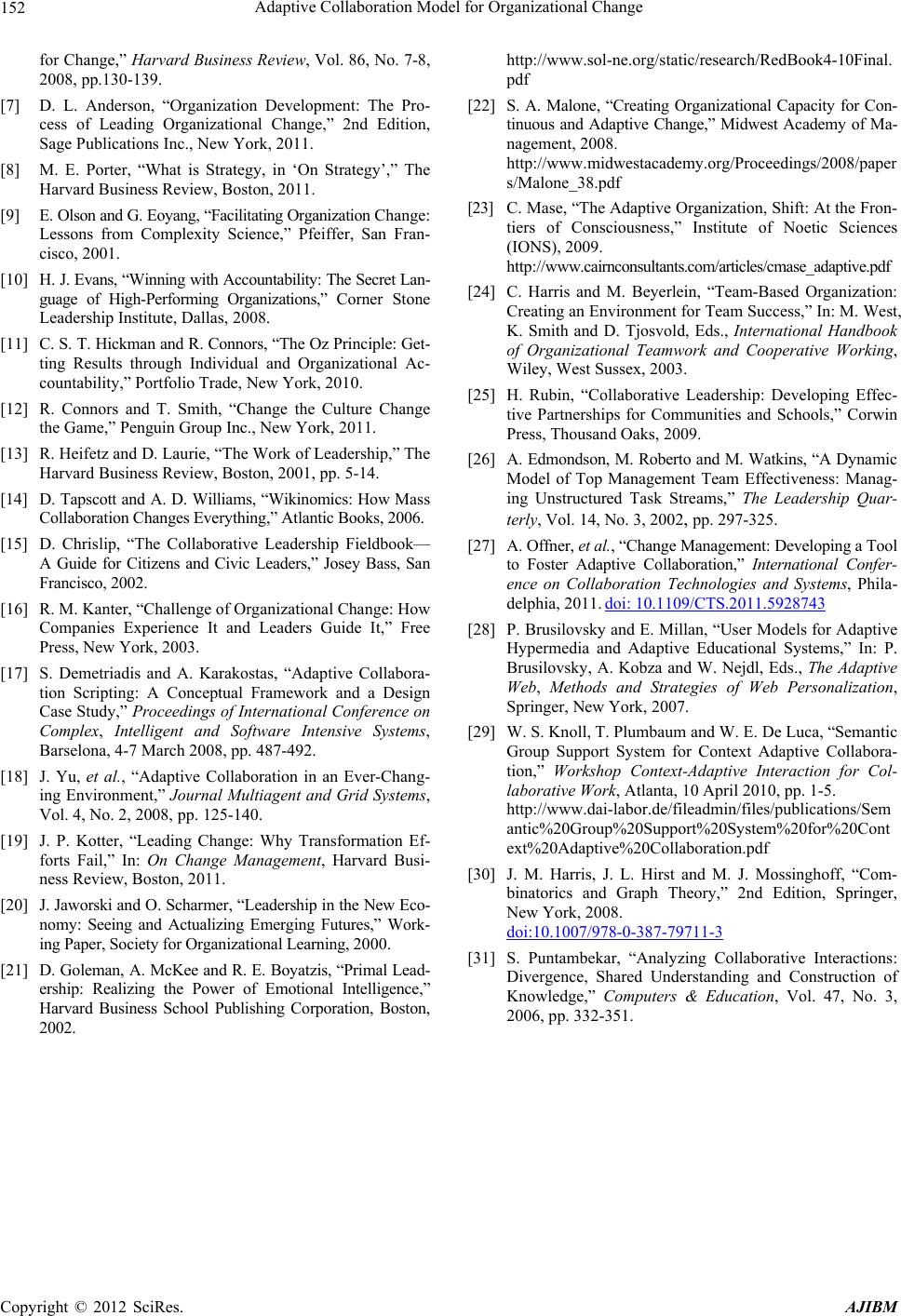 Adaptive Collaboration Model for Organizational Change Copyright © 2012 SciRes. AJIBM 152 for Change,” Harvard Business Review, Vol. 86, No. 7-8, 2008, pp.130-139. [7] D. L. Anderson, “Organization Development: The Pro- cess of Leading Organizational Change,” 2nd Edition, Sage Publications Inc., New York, 2011. [8] M. E. Porter, “What is Strategy, in ‘On Strategy’,” The Harvard Business Review, Boston, 2011. [9] E. Olson and G. Eoyang, “Facilitating Organization Change: Lessons from Complexity Science,” Pfeiffer, San Fran- cisco, 2001. [10] H. J. Evans, “Winning with Accountability: The Secret Lan- guage of High-Performing Organizations,” Corner Stone Leadership Institute, Dallas, 2008. [11] C. S. T. Hickman and R. Connors, “The Oz Principle: Get- ting Results through Individual and Organizational Ac- countability,” Portfolio Trade, New York, 2010. [12] R. Connors and T. Smith, “Change the Culture Change the Game,” Penguin Group Inc., New York, 2011. [13] R. Heifetz and D. Laurie, “The Work of Leadership,” The Harvard Business Review, Boston, 2001, pp. 5-14. [14] D. Tapscott and A. D. Williams, “Wikinomics: How Mass Collaboration Changes Everything,” Atlantic Books, 2006. [15] D. Chrislip, “The Collaborative Leadership Fieldbook— A Guide for Citizens and Civic Leaders,” Josey Bass, San Francisco, 2002. [16] R. M. Kanter, “Challenge of Organizational Change: How Companies Experience It and Leaders Guide It,” Free Press, New York, 2003. [17] S. Demetriadis and A. Karakostas, “Adaptive Collabora- tion Scripting: A Conceptual Framework and a Design Case Study,” Proceedings of International Conference on Complex, Intelligent and Software Intensive Systems, Barselona, 4-7 March 2008, pp. 487-492. [18] J. Yu, et al., “Adaptive Collaboration in an Ever-Chang- ing Environment,” Journal Multiagent and Grid Systems, Vol. 4, No. 2, 2008, pp. 125-140. [19] J. P. Kotter, “Leading Change: Why Transformation Ef- forts Fail,” In: On Change Management, Harvard Busi- ness Review, Boston, 2011. [20] J. Jaworski and O. Scharmer, “Leadership in the New Eco- nomy: Seeing and Actualizing Emerging Futures,” Work- ing Paper, Society for Organizational Learning, 2000. [21] D. Goleman, A. McKee and R. E. Boyatzis, “Primal Lead- ership: Realizing the Power of Emotional Intelligence,” Harvard Business School Publishing Corporation, Boston, 2002. http://www.sol-ne.org/static/research/RedBook4-10Final. pdf [22] S. A. Malone, “Creating Organizational Capacity for Con- tinuous and Adaptive Change,” Midwest Academy of Ma- nagement, 2008. http://www.midwestacademy.org/Proceedings/2008/paper s/Malone_38.pdf [23] C. Mase, “The Adaptive Organization, Shift: At the Fron- tiers of Consciousness,” Institute of Noetic Sciences (IONS), 2009. http://www.cairnconsultants.com/articles/cmase_adaptive.pdf [24] C. Harris and M. Beyerlein, “Team-Based Organization: Creating an Environment for Team Success,” In: M. West, K. Smith and D. Tjosvold, Eds., International Handbook of Organizational Teamwork and Cooperative Working, Wiley, West Sussex, 2003. [25] H. Rubin, “Collaborative Leadership: Developing Effec- tive Partnerships for Communities and Schools,” Corwin Press, Thousand Oaks, 2009. [26] A. Edmondson, M. Roberto and M. Watkins, “A Dynamic Model of Top Management Team Effectiveness: Manag- ing Unstructured Task Streams,” The Leadership Quar- terly, Vol. 14, No. 3, 2002, pp. 297-325. [27] A. Offner, et al., “Change Management: Developing a Tool to Foster Adaptive Collaboration,” International Confer- ence on Collaboration Technologies and Systems, Phila- delphia, 2011. doi: 10.1109/CTS.2011.5928743 [28] P. Brusilovsky and E. Millan, “User Models for Adaptive Hypermedia and Adaptive Educational Systems,” In: P. Brusilovsky, A. Kobza and W. Nejdl, Eds., The Adaptive Web, Methods and Strategies of Web Personalization, Springer, New York, 2007. [29] W. S. Knoll, T. Plumbaum and W. E. De Luca, “Semantic Group Support System for Context Adaptive Collabora- tion,” Workshop Context-Adaptive Interaction for Col- laborative Work, Atlanta, 10 April 2010, pp. 1-5. http://www.dai-labor.de/fileadmin/files/publications/Sem antic%20Group%20Support%20System%20for%20Cont ext%20Adaptive%20Collaboration.pdf [30] J. M. Harris, J. L. Hirst and M. J. Mossinghoff, “Com- binatorics and Graph Theory,” 2nd Edition, Springer, New York, 2008. doi:10.1007/978-0-387-79711-3 [31] S. Puntambekar, “Analyzing Collaborative Interactions: Divergence, Shared Understanding and Construction of Knowledge,” Computers & Education, Vol. 47, No. 3, 2006, pp. 332-351.
|